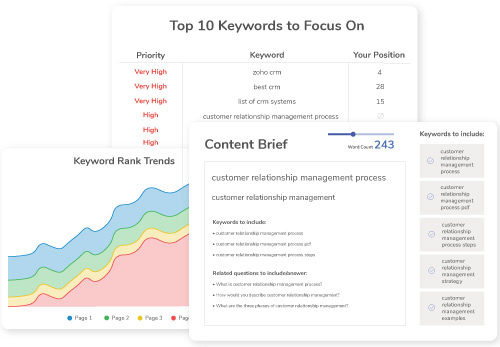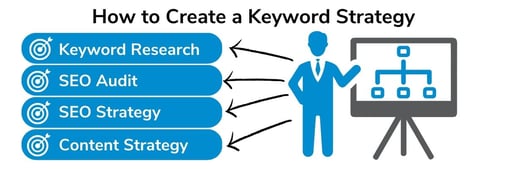SEO Keyword Strategy: The Ultimate Playbook
Creating an SEO keyword strategy for your business is one of the most important steps you can take for the success of your web content and digital marketing efforts. It’s the blueprint that will help you guide your content creation and measure your growth.
Why Is a Search Strategy Important?
With 89% of customers using search to assist with purchasing decisions, a search strategy is critical to being found by new customers. Without a keyword strategy example to guide your content planning, your investment in content creation could be wasted on the wrong topics or keywords. An SEO strategy in digital marketing will help you drive website traffic and—more importantly—conversions.
What Are the 4 Main Components of SEO?
Before you start your SEO keyword research, let’s go over the four elements of SEO that will help drive success.
Technical SEO
While most digital marketers focus on content, the back-end architecture of your website is equally important. Technical SEO is the process of optimizing the technical elements that allow search engines to engage with the site. Examples of this include the site’s code, page definitions, speed, accessibility, and responsiveness. Google’s algorithms increasingly punish the rankings of sites whose structure makes them less user-friendly.
It’s possible that you have limited influence on your site structure depending on how large of a company you work at and how your IT services are structured. In those cases, it’s worth reaching out to your webmaster to see if you can collaborate to improve your SEO.
Off-page SEO
Off-page SEO is how search engines use interactions from external sites and sources to evaluate a page’s authority. This typically takes the form of back-links from other websites–the more authoritative the better–but can also be influenced by social sharing and other factors.
On-page SEO
On-page SEO is the process of structuring your on-page content in a way that signals your relevant keywords and topics to search engines. On-page SEO elements include page titles, header tags, image alt tags, and meta descriptions. Making sure that these elements are present and optimized will help your content be found by your audience.
Content
If all of your technical, on-page, and off-page SEO is correct, you still need to produce engaging content that appeals to your audience. Make sure that you have a defined brand, voice, and style to give you the cohesiveness to build a brand following. Use your keyword research and other consumer research to determine what topics and types of content your audience will value.

How to Create a Keyword Strategy
How do you write a keyword strategy? Here are the elements that a good SEO keyword strategy should include:
- Keyword Research
- SEO Audit
- SEO Strategy
- Content Strategy
We’ll walk you through each of these below to learn how to get rolling on your keyword strategy.
Keyword Research
Let’s start with a keyword strategy definition: keyword research is the process of discovering which words and phrases your potential customers are using to search for services and websites like yours online. A keyword can range from a single short-tail word to a full phrase or question, known as a long-tail keyword.
How do you conduct proper keyword research? Here are a few steps for you to follow to get started:
Brainstorm
Before you start analysis, use your own knowledge to brainstorm keywords, services, and phrases relevant to your company. Talk to your sales team to get ideas for frequently asked questions and search terms. Remember, the terms your customers use to search likely won’t be the exact wording or industry terms that your internal team uses.
Select an SEO Keyword Tool
There are many SEO keyword tools on the market, ranging from free to paid. When developing a full SEO strategy, a robust keyword tool will serve you best. What is the best keyword tool? Look for a full-service content and SEO keyword research tool like DemandJump that offers precise search volumes analyzes competitive URLs and analyzes attribution insights.


Build Keyword Lists
Start with a core keyword list that encompasses your broad keywords, topics, and brand name. Next, build secondary lists that will speak to segments of your customer base, a specific product or service line, or a specific point in your marketing journey.
What is the best practice for good keyword selection? Your ideal keyword will have a high search volume and low competition for the best chance to gain traction more quickly. However, if you are in a highly competitive industry, you will likely still need to target high-competition keywords with high-quality, consistent content.
SEO Audit
To make a goal for growth, you need to understand where you stand. Export your top keyword lists and document your company’s rankings on your top keywords. Use tools like Google Analytics and Google Search Console to learn what percentage of your incoming traffic comes from organic search and what keywords customers are using to find your website.
Next, analyze your top three competitors to understand where they rank better than you, and what topics they may be covering that you are missing. At the same time, you don’t want to clone your industry leaders’ content. Look at your competitors’ best-ranking content to determine strengths, weaknesses, and opportunities to create even better content.
Once you have this baseline, set goals for where you’d like to be ranked in six months or a year. Set goals that are specific, realistic, and measurable to improve your rankings. Consult with your IT team to determine any weak technical SEO elements and how you can address them.
Content Strategy
Once you’ve identified keywords you want to target, you’re ready to start strategizing.
First, you’ll want to document what form your content will take. Take into consideration your audience and your resources at hand. Most SEO content strategy takes the form of a blog or long-form page content but can take many other forms such as video, tools, resources, or glossaries. With alt text and video captioning, there are growing possibilities for multimedia to be included in your search strategy. Determine where the content will live on your website, and if it will have any special branding.
Once you have a format identified, you’ll need to determine how often you’ll publish content and what resources you’ll need to produce it—whether in-house or external. Do you need a workflow tool that can create outlines and organize your briefs? We recommend creating a keyword strategy template that you can fill in to create briefs and a checklist for each piece of content to ensure that you aren’t forgetting any on-page SEO elements.
Finally, write a style and SEO guide to document best practices for on-page SEO elements you want to be included in your SEO content as well as the voice and style for your content.
Select Content Topics
To decide exactly what content to write, go back to your keyword list. Organize your keywords into 3-5 main topics that you want to improve your rankings on, with 8-10 keywords organized by category under each topic. These are known as content clusters.
For each topic, you’ll want to write an SEO pillar page that goes in-depth on the topic to demonstrate your knowledge of it. Next, write blogs or other shorter forms of content based on the keywords under that keyword.
Make sure to create internal links between your SEO pillar page and the related topical content, which helps establish authority on the topic for search engines. Learn the story of how we used this strategy to win over 90 first-page search rankings in just 5 months.
Content Promotion
Once you have your content plan in place, don’t forget to make a plan for how to promote it. Consider what channels you already have in place for promotion such as newsletters and social media, or new content promotion strategies you can start such as guest blogging to get your content out into the world. Remember, more views, shares, and links to your content will only help your visibility and rankings.

Measure and Track Your Success
If your SEO keyword strategy contains data about your current rankings and keyword volumes, measuring your success will be a piece of cake. We recommend following a 6-month SEO action plan of auditing your SEO rankings and conducting new keyword research every six months to measure your progress.
How do you track your success? Google Analytics and your keyword tool of choice can show your SEO growth over time. To demonstrate your value in the long run, though, you need to show marketing attribution that can tie campaigns, content, and search terms to conversions and revenue.
A complete picture of your attribution will help you tweak your strategy where it might need it—or take credit where credit is due when your SEO keyword strategy drives a big business impact.
DemandJump helps marketers prove their actions, drive pipeline, and grow revenue with consumer insights, content creation tools, and marketing attribution. Save time and get instant insights into your audience - get started today!












